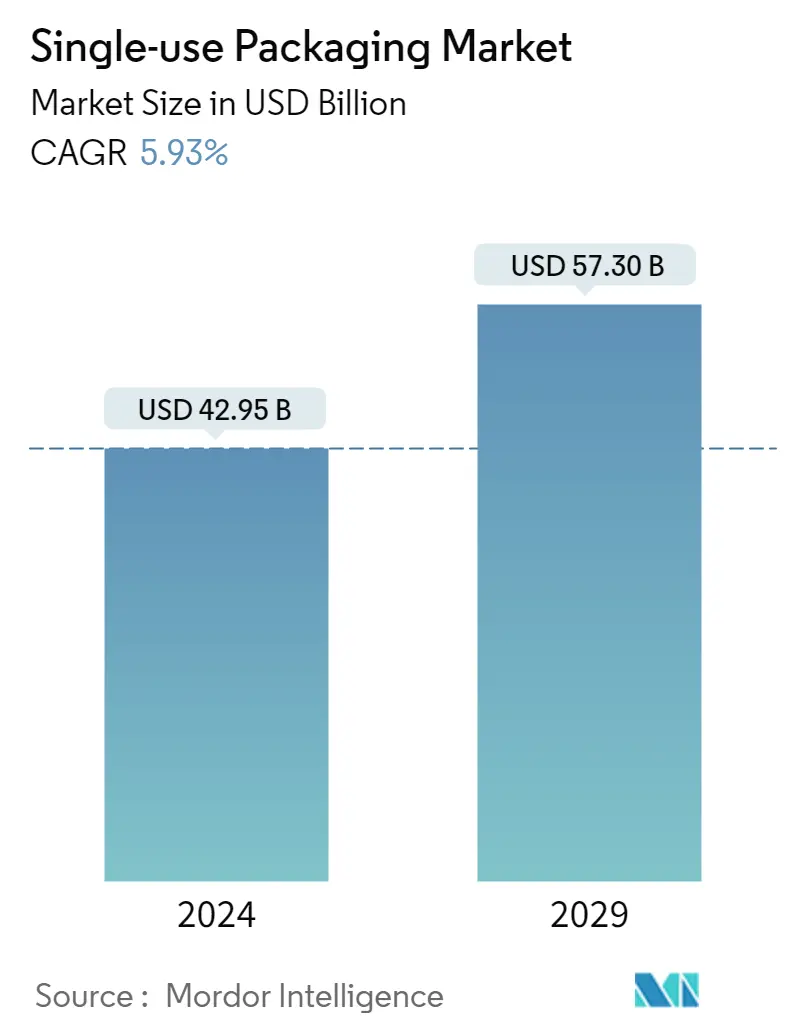Market Size of Single-use Packaging Industry

| Study Period | 2019 - 2029 |
| Market Size (2024) | USD 42.95 Billion |
| Market Size (2029) | USD 57.30 Billion |
| CAGR (2024 - 2029) | 5.93 % |
| Fastest Growing Market | Asia Pacific |
| Largest Market | Asia Pacific |
Major Players.webp)
*Disclaimer: Major Players sorted in no particular order |
Need a report that reflects how COVID-19 has impacted this market and its growth?
Single Use Packaging Market Analysis
The Single-use Packaging Market size is estimated at USD 42.95 billion in 2024, and is expected to reach USD 57.30 billion by 2029, growing at a CAGR of 5.93% during the forecast period (2024-2029).
- Single-use plastic packaging is in high demand because of urbanization, busy lifestyles, and the need for food and beverage drives the industry. The increase in the consumption of food and drink and the popularity of online food delivery are also driving the demand for single-use packaging. Due to its strength, versatility, affordability, and transparency, single-use plastic packaging has gained popularity across different industries.
- The changing consumer buying behavior and the increasing prevalence of flexible, cost-effective, and user-friendly packaging drive the market for single-use packaging. Using single-use food packaging is essential in preventing foodborne illness by eliminating the risk of contamination and transmission of diseases by using products intended to be used only once. Examples of single-use products can be found in various eateries, such as fast-food joints, takeaway restaurants, and catering facilities. In the modern era, most end-user industry organizations adopt designs essential for everyday life, such as single-use paper and plastic beverage cups, beverage lids, and straws and bottles.
- The emergence of e-commerce in developing countries such as China and India is expected to increase the demand for disposable packaging. Additionally, the need for packaging in the market is expected to be influenced by the growth of modern lifestyle changes and the expansion of the food and beverages industry, the home care industry, the healthcare industry, and the personal care industry impacted by the development of new e-commerce markets which drive the demand of Single-use packaging market.
- Further, the food industry has significantly transformed recently, with a new demand for cloud kitchens emerging. Cloud kitchens have seen a surge in popularity in recent years, as the concept of cloud kitchens has become increasingly accepted by consumers, particularly in the post-pandemic, when restaurants adopt online food delivery, and the transition occurs to takeout and delivery services due to user demand.
- The widespread use of plastic materials worldwide has posed a considerable threat to the environment, and governments and global regulatory bodies are taking steps to address this issue. To address this issue, developing countries such as India have banned the production, import, storage, distribution, sale, and use of identified single-use plastic products, which are of low utility and have a high littering potential. The list of prohibited items includes earbuds containing plastic sticks, plastic sticks for balloons, plastic flags, candy sticks, ice-cream sticks, thermocol for decoration, plastic plates, cups, glasses, cutlery, forks, and stirrers. Spoons, knives, straws, trays, wrapping or packing films surrounding sweet boxes, invitation cards, cigarette packets, and plastic or PVC banners, all smaller than 100 microns;
- Meanwhile, the war between Russia and Ukraine has resulted in economic sanctions against several countries, high commodity prices, supply chain disruptions, and impacts on many markets worldwide. Some Middle Eastern nations are very reliant on imports of food and energy, making them particularly susceptible to economic shocks brought on by the Ukraine crisis. The war between Russia and Ukraine has made raw material prices and energy costs rise in several countries with production facilities, high commodity prices, supply chain disruptions, and impacts on many markets. According to the Center for Strategic and International Studies, the war restricted food exports from Ukraine and Russia and increased the prices of these commodities. The rising cost of packaging materials and items has resulted in a decline in profit across the supply chain.
